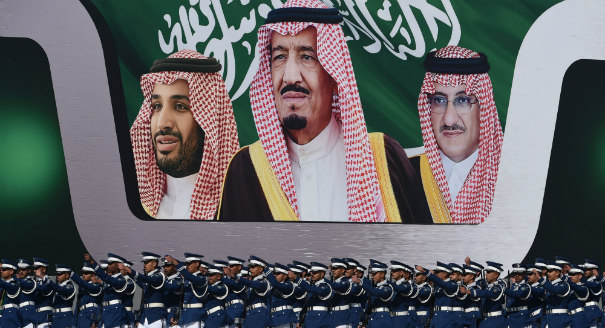Saudi Arabia has recently attempted to rebrand itself as the sole powerbroker in the region. The kingdom has also struggled to convince investors it has an enterprising and sustainable economy worth investing in—efforts embodied by Vision 2030, an economic plan launched in 2016 to increase local economic participation, diversify sources of income, and establish a stable domestic and foreign context to realize these goals. Meanwhile, Riyadh’s foreign policy moves and internal shifts of power highlight that its new, youthful leadership will aggressively pursue dominance in the region. Yet the manner in which the leadership is pursuing these goals could possibly obstruct its domestic economic plans.
One of the more consequential of these shifts was the removal of Crown Prince Mohammed Bin Nayef from the line of succession and his replacement with Deputy Crown Prince Mohammed Bin Salman on June 21. This was also the most pronounced change within the ruling establishment since King Salman Bin Abdulaziz came to power. Putting the young prince at the helm to lead during major transition makes sense, as he is already heading major economic and foreign policy initiatives. Notably, he is the architect of Vision 2030. However, rumors of discord within the house of Saud raise questions on whether this move was politically sound. In order to ensure popular support for his son’s promotion, King Salman issued royal decrees increasing employment opportunities in the public sector and reinstating many of the allowances and benefits for existing public sector employees that had been cut or suspended in September to decrease the budget deficit. These decisions undo many of the more conservative and ostensibly unpopular changes in fiscal policy and contradict Vision 2030’s key focus on decreasing government spending.
Saudi Arabia’s political stability and strong position in the region have been the basis for its new economic policy direction. However, news reports that former Crown Prince Mohammed Bin Nayef is under house arrest undermine the monarchy’s narrative of a smooth transition and domestic stability. Heavy spending to limit internal turbulence would cast doubt on whether the government could expand the private sector. Vision 2030 relies in part on attracting diverse foreign and local investment, based on the belief that a stable government can help the private sector flourish by creating policies and providing security for private capital. Investors are unlikely to trust their money in a country where the transfer of power is uncertain because the former crown prince under house arrest, as if he would be able to trigger some degree of unrest.
U.S. President Donald Trump’s visit in May during the Arab–Islamic–American summit involved much symbolic pageantry of placing Saudi Arabia as the region’s outright leader and reiterating that U.S.–Saudi relations are based on weapons, oil, and close strategic cooperation on regional political issues. Riyadh used this appearance of a united front to isolate and blockade Qatar, accusing it of funding terrorism. The bigger reason behind the blockade was likely Saudi Arabia’s impatience with Qatari (or Qatari-funded) efforts to undermine Saudi policies. Yet far from asserting Saudi power in the region—and stabilizing the country domestically, as MBS might have hoped—these moves cast doubt on the Gulf’s future stability, especially as oil production decreases. The Qatar blockade betrays the region’s palpable sense of discord and, more significantly, raises Saudi tensions with Qatari allies Iran and Turkey. It may also run Saudi Arabia into similar challenges to those it faces in its costly and damaging war in Yemen.
The moves to ostracize Qatar and consolidate control in the hands of Mohammed Bin Salman suggest a certain degree of deliberation on his part, due to Riyadh’s very detailed list of demands and quickly executed blockade. Yet while he controls both the Council for Economic and Development Affairs and the Ministry of Defense (not to mention holds the positions of first deputy prime minister and chief of the royal court), the timing of Qatar’s isolation suggests that perhaps Saudis have not assessed its probable impact on its own economy. For instance, over the past year Saudi Arabia has been considering an initial public offering (IPO) for 5 percent of Saudi ARAMCO, the country’s oil producer and perhaps the largest company in the world. ARAMCO’s valuation (estimated at about $1.5 to $2 trillion) could fluctuate if potential investors and political actors believe that Saudi Arabia must strain its budget to confront enemies on two borders. Although Saudi Arabia’s recent move to cut oil production in order to increase prices could ensure ARAMCO a higher valuation (as a reduced fiscal deficit and higher oil prices will both be a factor) has been relatively successful, it can only work for a short period given the uncertainty of the markets. Moreover, the overreliance on oil revenues to carry out the domestic and foreign agenda is very much against the spirit of Vision 2030.
Unless Riyadh can contain the negative impact of its succession and regional crises, Vision 2030 will have to take a backseat. If Saudi Arabia wants to forge ahead with Vision 2030, few options remain at its disposal. To cover the $72 billion needed for Vision 2030, it could consider a further increase—more than the tenfold increase already planned—to the Public Investment Fund (PIF), its sovereign wealth fund headed by the crown prince. With declining oil reserves, fluctuating prices, and a possible overall decrease in demands, Vision 2030 provides the inevitable change in course Saudi needs. Putting it on the backburner would in the long term undermine the essence of what drives Saudi Arabia—being a regional superpower.
Mohamed Elmeshad is an Egyptian journalist, researcher, and PhD candidate at the School of Oriental and African Studies (SOAS) in London.



.jpg)


